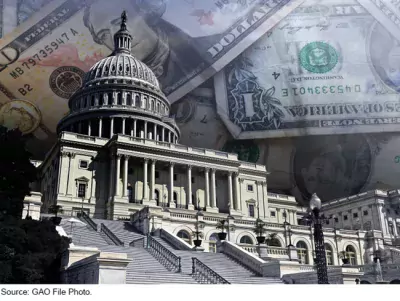Federal Financial Statements Continue to Show Serious Management Weaknesses
Each year, we audit the federal government’s financial statements—including spending, revenues, and debt. And we just completed our review of the FY 2021 statements, where we once again found the same serious financial management weaknesses that we had seen in previous years. These weaknesses hinder the federal government’s ability to have reliable, useful, and timely financial information to help it operate effectively and efficiently. We also highlighted the need for Congress to develop a plan for our nation’s fiscal future.
In today’s blog post, we look at the continuing and serious financial management weaknesses that have once again prevented us from providing an opinion on the reliability of the federal government’s financial statements. And we look at why it is so important that the government address them.
Image

Serious financial management weaknesses
To operate as effectively and efficiently as possible, Congress, the Administration, and federal managers must have ready access to reliable and complete financial and performance information. Without reliable financial information, which includes resolving some of the weaknesses we outline below, policymakers are not best positioned to plan for the nation’s fiscal future.
Our report discusses serious financial management weaknesses and ongoing efforts to address them, including:
- The Department of Defense (DOD)—which represents a significant portion of the federal government’s financial statements—continues to face serious, wide-spread, and long-standing financial management problems. DOD continues to take steps to improve its financial management. For example, in FY 2021 DOD reported that it resolved 13% of prior-year audit findings. However, as in prior years, DOD auditors were unable to provide an opinion on the reliability of DOD’s financial statements. DOD acknowledged that achieving a clean opinion will take time and is prioritizing critical areas for improvement.
- The federal government is not able to adequately account for transactions and balances between federal agencies and properly prepare the government’s financial statements. The Department of the Treasury (Treasury) is making progress toward addressing these weaknesses. For example, it issued additional accounting guidance for intragovernmental transactions and balances, and continues to assist federal agencies in better accounting for their transactions with other agencies. Also, Treasury implemented new federal agency financial statement requirements that more directly link agency information to information reported in the federal government’s financial statements.
- The Small Business Administration (SBA) continued to implement COVID-19 related relief for small businesses impacted by the pandemic. But the urgent need to provide relief as quickly and efficiently as possible left these programs vulnerable to fraud and improper payments. As a result of significant weaknesses related to these COVID-19 relief programs, SBA was not able to obtain an opinion on its financial statements, limiting the reliability of SBA’s financial reporting.
- Also, federal agencies reported improper payments (payments that should not have been made or were made in the incorrect amount) that are estimated to total about $281 billion for FY 2021. This amount does not include improper payment estimates related to certain programs, including some COVID-19 programs. The federal government is taking steps to address improper payments. However, the federal government is unable to determine the full extent to which improper payments occur and reasonably assure that appropriate actions are taken to reduce them.
Our long-term concerns
The 2021 financial statements contain long-term projections which show that, based on current revenue and spending policies, the federal government continues to face an unsustainable long-term fiscal path. Health care and Social Security spending are expected to continue to grow faster than GDP, according to long-term projections. In addition, the projections show that growing debt held by the public and higher interest rates will lead to more spending on interest, which will become the largest category of federal spending in 2034. Finally, the long-term projections show debt held by the public rising as a share of GDP in the long term. This situation—in which debt held by the public grows faster than GDP—means the current federal fiscal path is unsustainable.
Congress and the Administration have responded in an unprecedented manner to COVID-19—including trillions of dollars spent on the public health emergency and economic impacts of the pandemic. Once the pandemic recedes and the economy continues to recover, Congress and the Administration should quickly pivot to developing a plan to place the federal government on a sustainable long-term fiscal path. Well-designed fiscal rules and targets can help manage debt by controlling factors like spending and revenue as part of a long-term fiscal plan. Further, we have recommended that Congress consider alternative approaches to the current debt limit as part of any long-term fiscal plan.
Federal financial management improvements
Overall, the federal government has made significant strides in improving financial management since the Chief Financial Officers Act of 1990 was enacted. For example, 21 of 24 major agencies received clean opinions on their FY 2021 financial statements, up from six agencies for FY 1996. But still more needs to be done. You can find out about the progress and challenges remaining in federal financial management by checking out our August 2020 report.
- Comments on GAO’s WatchBlog? Contact blog@gao.gov.






